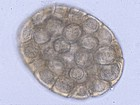Difference between revisions of "Dipylidium caninum"
m (Text replace - "Category:To_Do_-_Max" to "") |
|||
| Line 1: | Line 1: | ||
| − | {{ | + | {{OpenPagesTop}} |
| − | |||
{{Taxobox | {{Taxobox | ||
|name =''Dipylidium caninum | |name =''Dipylidium caninum | ||
| Line 30: | Line 29: | ||
Complete development in the intermediate hosts lasts around 1 month. The final host is infected via ingestion of the [[Fleas|flea]] or [[Lice|louse]], containing the cysticercoid. | Complete development in the intermediate hosts lasts around 1 month. The final host is infected via ingestion of the [[Fleas|flea]] or [[Lice|louse]], containing the cysticercoid. | ||
| − | = | + | {{Learning |
| − | + | |literature search = [http://www.cabdirect.org/search.html?q=title%3A%28%22Dipylidium+caninum%22%29 ''Dipylidium caninum'' publications] | |
| + | }} | ||
| − | + | {{review}} | |
| − | |||
| − | |||
| + | {{OpenPages}} | ||
[[Category:Cyclophyllidea]] | [[Category:Cyclophyllidea]] | ||
[[Category:Expert_Review]] | [[Category:Expert_Review]] | ||
Revision as of 18:52, 5 July 2012
| Dipylidium caninum | |
|---|---|
| Kingdom | Animalia |
| Phylum | Platyhelminthes |
| Class | Cestoda |
| Sub-class | Cyclophyllidea |
| Family | Dipylidiidae |
| Genus | Dipylidium |
| Species | D. caninum |
Also known as: Double-pored tapeworm — Cucumber seed tapeworm
Introduction
D. caninum is a very commonly seen parasite of dogs and cats, and of the class Cestoda. They are capable of growing up to 50cm in length in the small intestine. It is of minor clinical significance, causing no more than occasional anal irritation. Diarrhoea may result if the tapeworms are present in large numbers. The proglottids are motile and can upset owners when they drop onto the furniture or floor.
Identification
D. caninum resemble Taenia spp, but are considerably shorter than Taenia. D. caninum have a scolex and a proglottid, which are easily recognized in this species. This parasite also has two sets of genital organs.
The eggs are 25-50μm in length.
Life-Cycle
The oncospheres are within the egg packets. These are ingested by the intermediate host. They develop into cysticercoids, which is infective by the time that metamorphosis is complete.
Complete development in the intermediate hosts lasts around 1 month. The final host is infected via ingestion of the flea or louse, containing the cysticercoid.
| Dipylidium caninum Learning Resources | |
|---|---|
 Search for recent publications via CAB Abstract (CABI log in required) |
Dipylidium caninum publications |
| This article has been peer reviewed but is awaiting expert review. If you would like to help with this, please see more information about expert reviewing. |
Error in widget FBRecommend: unable to write file /var/www/wikivet.net/extensions/Widgets/compiled_templates/wrt663173510d94d5_01231647 Error in widget google+: unable to write file /var/www/wikivet.net/extensions/Widgets/compiled_templates/wrt6631735110e3f7_97335601 Error in widget TwitterTweet: unable to write file /var/www/wikivet.net/extensions/Widgets/compiled_templates/wrt6631735113bd39_87584634
|
| WikiVet® Introduction - Help WikiVet - Report a Problem |
